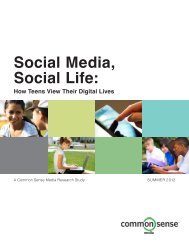Higher Education: Gaps in Access and Persistence Study
Higher Education: Gaps in Access and Persistence Study
Higher Education: Gaps in Access and Persistence Study
Create successful ePaper yourself
Turn your PDF publications into a flip-book with our unique Google optimized e-Paper software.
atta<strong>in</strong>ment. Among males who had not completed high<br />
school, a higher percentage of Hispanics (77 percent) were<br />
employed than White (55 percent) or Black males<br />
(28 percent). Also, a higher percentage of White males<br />
than Black males <strong>in</strong> this group were employed.<br />
Among young adults whose highest level of educational<br />
atta<strong>in</strong>ment was high school completion, 67 percent<br />
were employed <strong>in</strong> 2010 overall, with a higher rate of<br />
employment for males than for females (72 vs.<br />
60 percent). This difference by sex was also observed<br />
among Whites <strong>and</strong> Hispanics. Among males, a lower<br />
percentage of Blacks (52 percent) were employed,<br />
compared to Whites (74 percent), Hispanics (78 percent),<br />
<strong>and</strong> Asians (76 percent).<br />
For young adults whose highest level of atta<strong>in</strong>ment was<br />
at least a bachelor’s degree, 85 percent were employed <strong>in</strong><br />
2010 overall, with a higher employment rate for males<br />
than for females (89 vs. 82 percent). In addition, higher<br />
percentages of White, Hispanic, <strong>and</strong> Asian males than<br />
females with a bachelor’s or higher degree were employed.<br />
Median Earn<strong>in</strong>gs <strong>and</strong> Employment of Young<br />
Adults With STEM Degrees<br />
The 2010 median annual earn<strong>in</strong>gs of young adults ages 25<br />
to 34 who worked full time throughout a full year were<br />
$36,200. Median earn<strong>in</strong>gs for males whose highest level<br />
of educational atta<strong>in</strong>ment was high school completion<br />
exceeded those for females by about $5,100 ($30,200<br />
vs. $25,100). Median earn<strong>in</strong>gs were also higher for male<br />
than female high school completers among Whites,<br />
Blacks, Hispanics, Asians, <strong>and</strong> Native Hawaiians/Pacific<br />
Isl<strong>and</strong>ers. Median annual earn<strong>in</strong>gs for young adults with<br />
a bachelor’s or higher degree were $50,300 <strong>in</strong> 2010, <strong>and</strong><br />
male earn<strong>in</strong>gs for this group exceeded female earn<strong>in</strong>gs<br />
by about $9,100 ($54,400 vs. $45,300); this difference by<br />
sex was also observed among Whites, Blacks, Hispanics,<br />
Asians, <strong>and</strong> young adults of two or more races.<br />
Median earn<strong>in</strong>gs for young adults with a bachelor’s or<br />
higher degree <strong>in</strong> a STEM field (STEM graduates) were<br />
$58,200, about $7,900 higher than the overall average<br />
for young adults with a bachelor’s or higher degree <strong>in</strong> any<br />
field. Male earn<strong>in</strong>gs for STEM graduates exceeded those<br />
for females by about $8,200 ($60,400 vs. $52,200). This<br />
pattern by sex also held for Whites, Blacks, Hispanics,<br />
Asians, <strong>and</strong> young adults of two or more races. Among<br />
males, STEM earn<strong>in</strong>gs for Asians ($69,900) were higher<br />
than earn<strong>in</strong>gs for White males ($60,400), males of two<br />
or more races ($60,400), Hispanic males ($53,300), Black<br />
males ($51,800), <strong>and</strong> American Indian males ($43,800).<br />
Multivariate Analyses<br />
Immediate Postsecondary Enrollment<br />
After controll<strong>in</strong>g for race/ethnicity, socioeconomic status,<br />
<strong>and</strong> other background variables, among sophomores <strong>in</strong><br />
2002 who graduated from high school by August 2004<br />
(referred to as “on-time” high school graduates), females<br />
were more likely than males to immediately enroll <strong>in</strong><br />
postsecondary education. This pattern held for White<br />
<strong>and</strong> Hispanic on-time graduates but not for Blacks. In<br />
contrast, for Black females who graduated on-time from<br />
high school <strong>in</strong> August 2004, there was no measurable<br />
difference from their male counterparts <strong>in</strong> the likelihood<br />
of enroll<strong>in</strong>g <strong>in</strong> their first postsecondary <strong>in</strong>stitution by<br />
December 2004.<br />
Immediate enrollees had higher levels of socioeconomic<br />
status compared with students with no immediate<br />
postsecondary enrollment, a higher mean 9th-grade<br />
grade po<strong>in</strong>t average (GPA), <strong>and</strong> a higher mean 10th-grade<br />
mathematics achievement test score. In addition, higher<br />
percentages of immediate enrollees (than those who did<br />
not immediately enroll <strong>in</strong> postsecondary education)<br />
were from two-parent/guardian households, participated<br />
<strong>in</strong> sports, participated <strong>in</strong> two or more extracurricular<br />
activities, <strong>and</strong> often discussed coursework with their<br />
parents. Lower percentages of immediate enrollees (than<br />
those who did not immediately enroll <strong>in</strong> postsecondary<br />
education) were ever reta<strong>in</strong>ed <strong>in</strong> 10th grade or earlier,<br />
were absent from school seven or more times <strong>in</strong> the first<br />
semester, had cut or skipped classes seven or more times,<br />
were employed <strong>and</strong> work<strong>in</strong>g more than 30 hours a week,<br />
or had at least one close friend who dropped out of school.<br />
These overall f<strong>in</strong>d<strong>in</strong>gs varied by race/ethnicity <strong>and</strong> sex.<br />
Results <strong>in</strong>dicate that the odds of a male immediately<br />
enroll<strong>in</strong>g <strong>in</strong> postsecondary education were 35 percent<br />
lower than the odds for a female, after account<strong>in</strong>g for<br />
other student, family, <strong>and</strong> high school characteristics<br />
that were <strong>in</strong>cluded as <strong>in</strong>dependent variables <strong>in</strong> the model.<br />
In terms of race/ethnicity, the odds of an Asian student<br />
immediately enroll<strong>in</strong>g <strong>in</strong> postsecondary education after<br />
high school were 2.57 times the odds for a White student.<br />
While the unadjusted bivariate results <strong>in</strong>dicated that lower<br />
percentages of Black than White high school graduates<br />
immediately enrolled <strong>in</strong> postsecondary education,<br />
the logistic models <strong>in</strong>dicate that Black students had<br />
50 percent higher odds than White students of<br />
immediately enroll<strong>in</strong>g <strong>in</strong> postsecondary education, after<br />
account<strong>in</strong>g for other student, family, <strong>and</strong> school factors.<br />
Degree Atta<strong>in</strong>ment<br />
Among beg<strong>in</strong>n<strong>in</strong>g postsecondary students who<br />
were recent high school graduates <strong>in</strong> 2004, after<br />
controll<strong>in</strong>g for race/ethnicity, socioeconomic status,<br />
<strong>and</strong> other background variables, females were more<br />
likely than males to have completed an associate’s or<br />
bachelor’s degree program by 2009. This pattern was<br />
also observed for Whites <strong>and</strong> Blacks. However, for<br />
beg<strong>in</strong>n<strong>in</strong>g postsecondary Hispanic students who were<br />
recent high school graduates, there was no measurable<br />
difference between males <strong>and</strong> females <strong>in</strong> the likelihood of<br />
complet<strong>in</strong>g an associate’s or bachelor’s degree program by<br />
2009.<br />
<strong>Higher</strong> percentages of students who had atta<strong>in</strong>ed an<br />
associate’s or bachelor’s degree by 2009 than those<br />
Executive Summary<br />
Executive Summary xv












